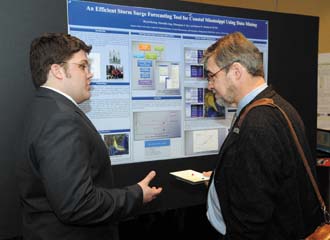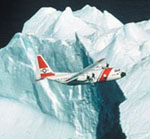For Security, the Future Begins Now
 |
Bryan Herring (l) describes his study about forecasting storm surges and flooding to an attendee at the U.S. Department of Homeland Security’s University Network Summit in March 2010. Herring won the Science and Technology Directorate’s Impact Award for his research. |
The U.S. Department of Homeland Security is investing in the exploration of solutions to problems that have not yet reared their ugly heads. On its way to discovering countermeasures for the threats it foresees, the department also is using what it has learned to avert incidents that could have had much more disastrous results and cost
Predicting and addressing future needs is one focus area for the Department of Homeland Security’s (DHS’) Science and Technology Directorate, Washington, D.C. Specifically, the directorate’s Office of University Programs assembles scientists and subject matter experts in 12 centers of excellence (COEs) located nationwide, a number that is likely to decrease to 10 or even nine as time goes on and as focuses narrow, says Matthew Clark, director of the office. The purpose of the centers is not to create vaporware but rather to develop practical solutions that solve today’s problems with an eye toward dangers that could be lurking just around the bend.
“The way I describe it is that I want Nobel-quality research, and I want it tomorrow morning,”
His wit comes from passion, not playfulness. In fact, the centers deal with some grave issues. The COEs are one of three focus areas for DHS’ Office of University Programs; the others are the Science, Technology, Engineering and Mathematics education programs and the Minority Serving Institutions programs. Research, experimentation, testing, modeling and simulation are being conducted in various areas today that may lead to solutions 10 years down the road. Although some of the results will require years to gestate, others have occurred soon after research began,
The COEs’ projects range “from the sublime to the prosaic.” The University Programs budget has three line items—COEs, scholarships and fellowships, and minority-serving institutions and awards—but over the years these three have converged as the latter two have melded into the COEs. “What we’re trying to do is make a connection. We want an integrated network so that they use each other’s research instead of reinventing the wheel. That’s one of the things that infuriate me the most: I don’t want to see any unforeseen or unnecessary duplications. I don’t care if two people approach a problem from different aspects and then you look at the different results and ask what does this mean. I don’t want somebody not knowing what others are doing. So, what we want to do is build a pipeline. This is a means for new aspects of integrating disciplines, a new application of a wide range of sciences—everything from physics to a lot of engineering to social sciences.
“This has been a real boon for the social scientists because there weren’t that many people out there studying terrorism and behavioral sciences. That’s where the action is. Unless we can get our act together on the behavioral science side, everything else we do is not as effective as it could be,”
He admits that scientists in the COEs are not trying to predict how every group is going to act but rather attempting to narrow the error file. For example, the National Consortium for the Study of Terrorism and Responses to Terrorism, a COE led by the University of Maryland, has created an open-source database of approximately 100,000 terrorism events that have occurred from 1972 to the present. The information is available publicly so anyone can study it with a goal of improving the models used to test and create solutions.
Uses for all of this information are not yet clear and are likely to evolve as data is added and national security priorities change. At this point, one focus area is attempting to determine the various reasons terrorists use acts of violence. While one incident may aim at instilling fear or obtaining power, another may have economic goals. “The truth is that regardless of their objectives, they are behaving very rationally like firms. There hasn’t been a lot of analysis of terrorist organizations as firms. Once you recognize their objectives function and understand what they are going to attack, you can attack their supply chain much more easily,” he explains. “That’s the kind of project that we need the intelligence agencies involved in, but it is a complex and interesting problem.”
 |
The U.S. Coast Guard International Ice Patrol is responsible for monitoring the movement of icebergs in the Arctic to ensure safe navigation of shipping lanes in the North Atlantic. The Coast Guard called on the Center of Excellence (COE) co-led by the University of Hawaii and University of Alaska–Fairbanks to help it assess the ice melt situation in the Arctic. |
Despite this user-focused approach, the COEs must follow the guidelines both Congress and the 9/11 Commission prescribed when envisioning this group: conduct multidisciplinary research in DHS’ mission areas. It is difficult to put a finger on the precise number of COE people or projects because it is a moving target. “There are a total of approximately 200 universities in the system at any one time. If you add them up over time, a total of 360 universities have been part of the COEs,”
In September, DHS’ Science and Technology Directorate selected its latest COE, the University of Southern California (USC), to lead its newest center; its focus area will be Risk, Economics and Operations Research of Terrorism and All Hazards (REOR). For this project, the university receives a multiyear grant of up to $3.3 million per year over a period of five years. This latest center replaces an existing COE at the university. The Center for Risk and Economic Analysis of Terrorism Events explored how
The centers address not only terrorist-related events but also threats to
These outcomes of center’s work are examples of COEs’ power, and work underway at all of the centers has implications for the future through the wonders of modeling and simulation. Access to volumes of data enables center personnel to facilitate predicting how best to provide protection with a higher degree of certainty in a variety of areas that range from securing facilities to guarding airline passengers, he adds.
Some ideas that come through the COEs go from idea to action in days and weeks rather than years. For example, two USC graduate students—one a computer scientist and the other a game theory specialist—put together a system for determining the relative value and vulnerability of transported assets. Because of their connection with
The solution came to the attention of the USC COE, which notified the Federal Air Marshals, who could now use it to determine which flights should include marshals.
Congress designated seven schools to work on the issues surrounding transportation security. Led by the
The amount of data that 11 of the centers are producing creates the need for the 12th one—the Center of Excellence in Command, Control and Interoperability (C2I), which is co-led by Purdue University and Rutgers University. The former focuses on visualization sciences and the latter concentrates on data sciences.
Law enforcement and emergency response is only one example of the work this center can conduct. To evaluate how his own department is operating,
The COE examination project led to an interesting map,
Funding for the COEs involves two mechanisms: the government and private investment. In fiscal year 2009, for example, the majority of centers’ funding came from what
A set of 12 basic ordering agreements had been put into place that are no-money contracts. The Office of University Programs worked closely with Office of Procurement Operations to come up with a tool that would allow DHS to take advantage of the nearly $250 million that has been invested in COEs over the years. The basic ordering agreements ensure that the centers have reach-back capability that enables them to tap into the best experts in their field anywhere in the world to help DHS fulfill its missions,
WEB RESOURCES
Department of Homeland Security (DHS) Centers of Excellence: www.dhs.gov/files/programs/editorial_0498.shtm
DHS Science and Technology Directorate: www.dhs.gov/files/scitech.shtm




Comments